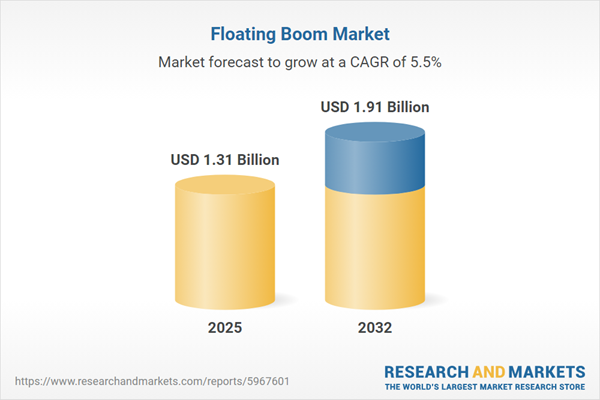Speak directly to the analyst to clarify any post sales queries you may have.
The floating boom market is undergoing transformational shifts as organizations demand agile containment measures to safeguard operations and meet stricter compliance obligations. Senior decision-makers are increasingly focused on responsive solutions that align asset protection with fast-evolving environmental and regulatory expectations.
Market Snapshot: Floating Boom Market Trends
As of 2024, the floating boom market stands out for its strong momentum and growing market value, reaching USD 1.24 billion. Forecasts project significant expansion, with the sector poised to achieve USD 1.91 billion by 2032. This anticipated growth is driven by persistent demand from both public and private entities that are prioritizing dependable risk management strategies. The enhanced focus on operational stability is propelling innovation, as advanced boom designs enable organizations to deploy containment systems more flexibly even in highly variable environments. Regulatory frameworks remain a determining influence, often shaping procurement practices so solutions meet both compliance and operational agility standards. Technology adoption, particularly in monitoring and deployment, is increasingly central to investment and risk mitigation plans across the sector.
Scope & Segmentation: Comprehensive Floating Boom Solutions
- Product Types: Hard booms leverage robust materials, such as aluminum, steel, or plastic composites, to offer extended performance in aquatic containment where long-term durability is critical.
- Product Types: Inflatable booms utilize single or multi-chamber construction for rapid deployment and repositioning, supporting dynamic incident response across multiple sites or evolving situations.
- Product Types: Water-filled booms deliver adaptable containment, effectively responding to changes in water levels and unique site conditions while ensuring operational consistency.
- Applications: These solutions address freshwater management, industrial spill containment, and marine safety, enabling organizations to comply with regulatory and industry safety mandates.
- End Users: Key stakeholders include government agencies, maritime operators, port authorities, oil and gas companies, and industrial organizations that depend on floating booms to support integrated risk management.
- Materials: Neoprene, PVC-coated fabrics, and polyethylene are employed to enhance product resilience against chemical and water exposure, helping extend product lifecycle and reduce ownership costs.
- Deployment Modes: Permanent installations are suited for protecting fixed assets, while portable models provide rapid response capabilities for diverse regulatory and site-specific requirements.
- Regional Markets: Demand dynamics vary across the Americas, Europe, Middle East and Africa, and Asia-Pacific due to differing regulatory mandates, climate variances, and adoption rates of emerging containment technologies.
- Technology Adoption: Integration of analytics, remote monitoring, and autonomous retrieval tools boosts visibility, streamlines compliance reporting, and strengthens central asset control.
- Company Coverage: Key industry contributors—Bridport Manufacturing Co., Inc., Buffalo Inc., Lamor Corporation, VIKOMA International Ltd., Tocron International, Diversified Plastics, Inc., Oil Spill Response Limited, and Oskar Pedersen AS—deliver tailored products and proprietary technology to support operational and regulatory objectives.
Key Takeaways for Senior Decision-Makers
- Modern materials and coatings are offering improved durability, making system maintenance easier in chemically challenging or high-wear environments.
- Adoption of IoT-based monitoring provides advanced visibility for asset management and paves the way for predictive maintenance across distributed sites.
- Geographic customization enables organizations to accelerate regulatory approval processes and maintain compliance as legislation evolves.
- Cross-sector partnerships are accelerating technology integration, helping address compliance gaps and risk management challenges unique to each market segment.
- Implementation of modular system architecture empowers procurement and operations teams to control lifecycle expenditure and enhance adaptive planning.
- Digital transformation within supply chain management is reinforcing delivery consistency and supporting resilience in dynamic regulatory and sourcing conditions.
Tariff Impact: Navigating Changes in U.S. Trade Policy
Recent changes in U.S. tariff regulations have prompted floating boom suppliers to revise sourcing and production models. Enhanced focus on domestic manufacturing and a shift toward diversified supplier networks are supporting cost control and flexibility. Advancements in modular product development allow procurement leaders to make agile acquisition decisions. These industry responses aim to balance cost predictability and operational continuity, encouraging suppliers to strengthen both distribution and supply chain processes.
Methodology & Data Sources
This report is anchored by comprehensive secondary market research, cost analysis, and insights from industry-verified sources. All findings and recommendations are validated to align with the strategic objectives of senior leadership in the floating boom sector.
Why This Report Matters for Decision-Makers
- Provides actionable benchmarks for vendor evaluation to inform procurement strategies and support both compliance and operational needs.
- Clarifies the complex roles of regulation, technology trends, and industry alliances in shaping evolving risk management and sourcing approaches.
- Enables organizations to anticipate and adapt to fluctuations in supply chain dynamics and policy landscapes for stronger long-term planning.
Conclusion
This report delivers focused insights to support compliance, optimize monitoring technologies, and strengthen resilient floating boom operations within an evolving industry landscape.
Additional Product Information:
- Purchase of this report includes 1 year online access with quarterly updates.
- This report can be updated on request. Please contact our Customer Experience team using the Ask a Question widget on our website.
Table of Contents
3. Executive Summary
4. Market Overview
7. Cumulative Impact of Artificial Intelligence 2025
Companies Mentioned
The companies profiled in this Floating Boom market report include:- Bridport Manufacturing Co., Inc.
- Buffalo Inc.
- Lamor Corporation
- VIKOMA International Ltd.
- Tocron International, Inc.
- Diversified Plastics, Inc.
- Oil Spill Response Limited
- Oskar Pedersen AS
Table Information
| Report Attribute | Details |
|---|---|
| No. of Pages | 196 |
| Published | November 2025 |
| Forecast Period | 2025 - 2032 |
| Estimated Market Value ( USD | $ 1.31 Billion |
| Forecasted Market Value ( USD | $ 1.91 Billion |
| Compound Annual Growth Rate | 5.5% |
| Regions Covered | Global |
| No. of Companies Mentioned | 9 |









